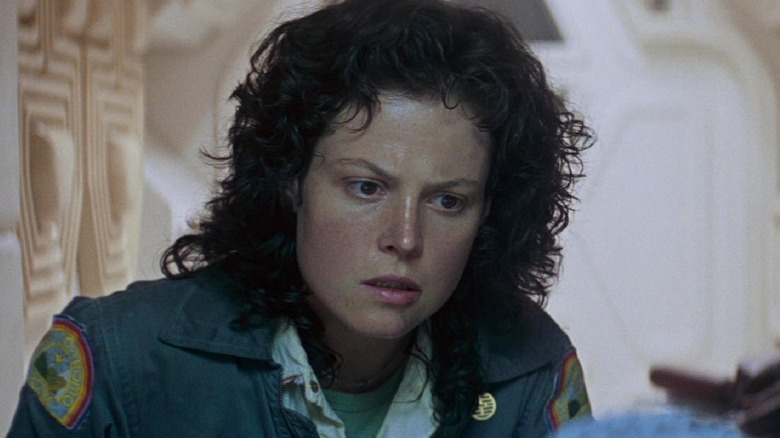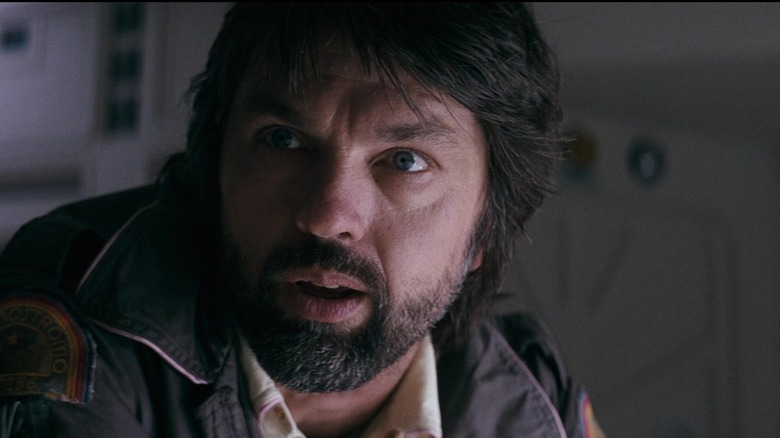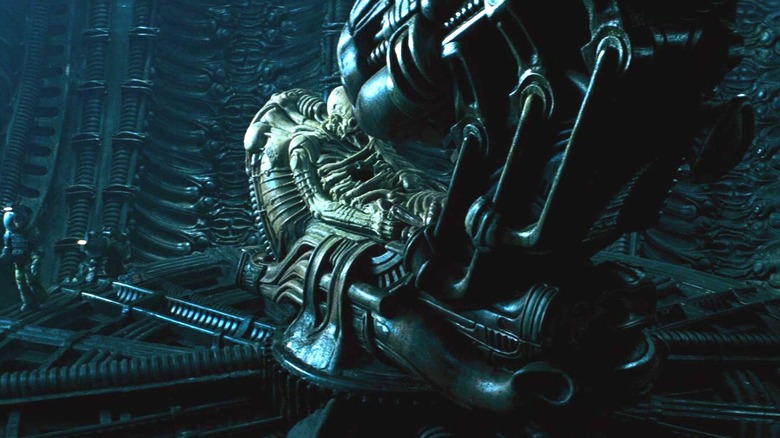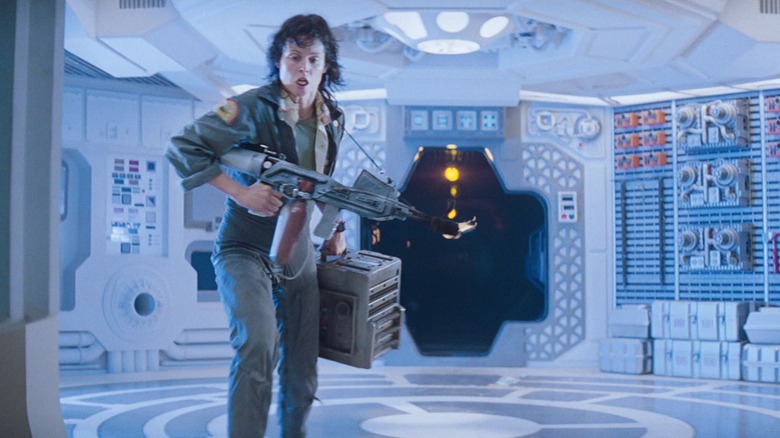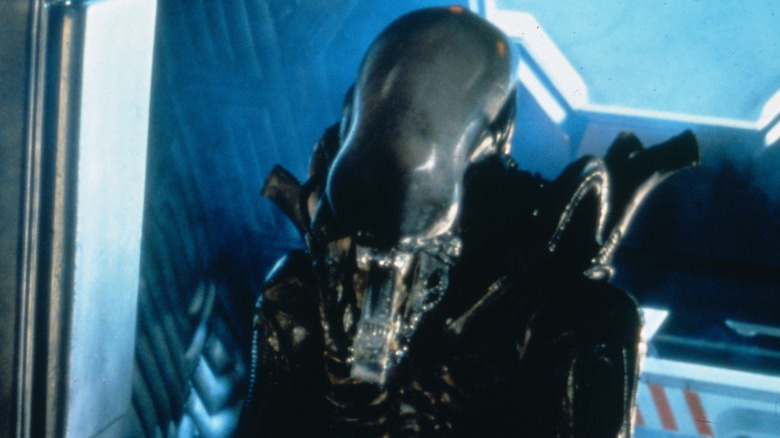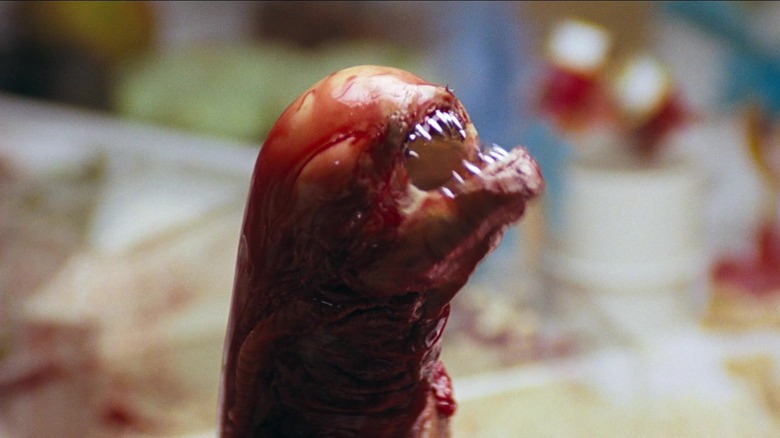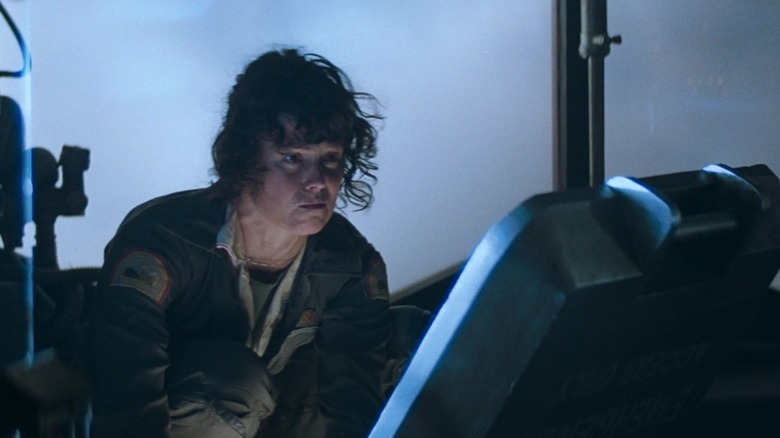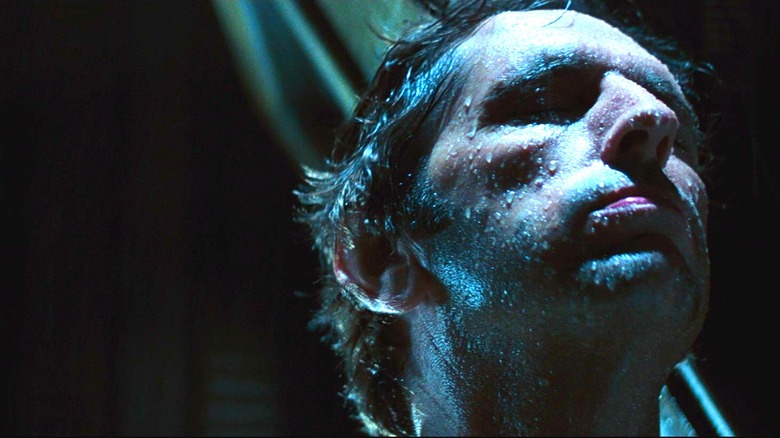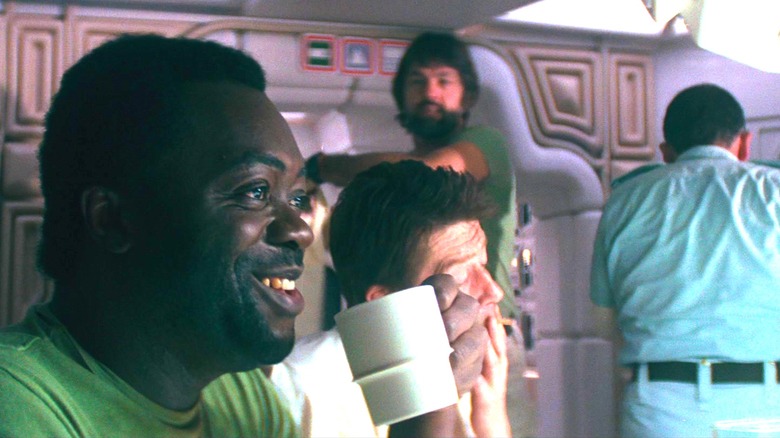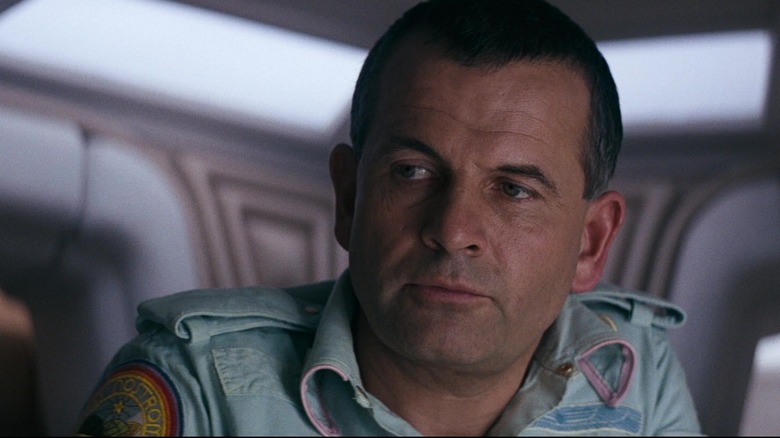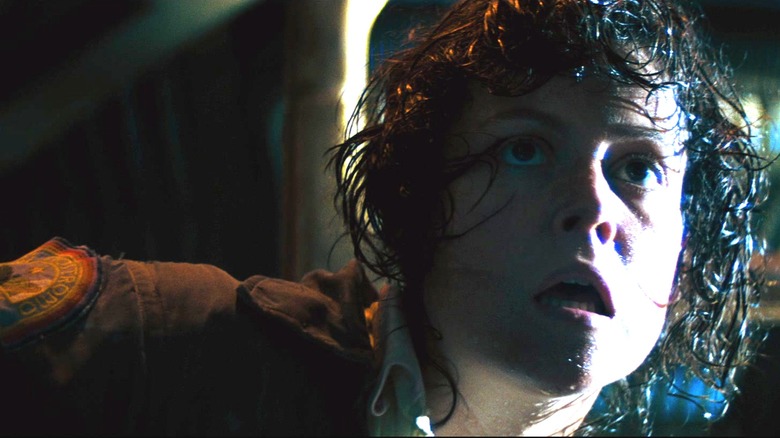How Alien Changed Movies And No One Noticed
When Kane (John Hurt) gave birth to a baby Xenomorph in 1979's "Alien," he also gave birth to a new type of sci-fi movie. Once "Alien" hit theaters, the sci-fi and horror genres were never the same again. Everyone knows that "Alien" was unlike any sci-fi movie that had come before it, but few people realize just how deeply this classic movie impacted the film industry.
This iconic movie changed who could star in a genre movie and what the aliens could look like. It also pioneered the visual aesthetic of horror movies and revolutionized the way the industry made movie trailers. So many movies owe "Alien" a debt, including everything from "Predator" to the James Bond franchise. There's even a "Star Trek" movie that was clearly influenced by this chestbursting classic.
But we suppose we should expect nothing less from a film that is arguably a "perfect organism." Here are all the ways that "Alien" changed Hollywood, the sci-fi genre, and the filmmaking game.
It kicked off the career of Ridley Scott
Although Ridley Scott had been working as a production designer and directing commercials for more than a decade, his career didn't take off until "Alien," a movie that thrust Scott into the spotlight. After directing his first feature film, 1977's "The Duellists," Scott planned on directing another period piece called "Tristan and Isolde." But then, as luck would have it, he watched "Star Wars: Episode IV — A New Hope," and it opened up his mind to the possibilities of cinema.
In an interview with The Hollywood Reporter, Scott recalled asking himself, "Why on earth am I even thinking about doing 'Tristan and Isolde' when this guy is doing this kind of movie?" Afterward, Scott vowed to create a sci-fi movie as groundbreaking as "Star Wars." Of course, he didn't want to just copy George Lucas. (In fact, Ridley Scott doesn't think he could ever direct a "Star Wars" movie.) Instead, he developed a project that would eventually become "Alien."
It's strange to think that if the stars hadn't aligned, we might never have seen any of the other sci-fi classics that Scott gave the world. Without "Alien," there would be no "Blade Runner" or "The Martian." And since "The Duellists" didn't perform well commercially, we might not have gotten Scott's later historical epics either. His career might not have lasted long enough for him to make "Black Hawk Down" or "Gladiator." All of these movies owe their existence to "Alien."
Alien brought horror movies to space
Strictly speaking, "Alien" was not the first horror movie set in space. Films such as "It! The Terror from Beyond Space" (1958) and "Planet of the Vampires" (1965) beat it to the punch. However, these were mostly campy B-movies with unconvincing effects. They were also a totally different genre from the slasher movies that dominated the horror market around the time "Alien" was released. "Alien" demonstrated that you could transport a gritty horror movie to outer space without losing any of the scares or gore.
The film inspired countless others to put their own spin on this emerging genre, such as "Pitch Black" and "Pandorum," while also spawning a slew of copycats that totally ripped off "Alien." Inevitably, existing horror franchises wanted to get in on the space action, regardless of whether or not it actually made sense: Pretty soon we had "Jason X," "Hellraiser: Bloodline," and "Leprechaun 4: In Space." (We still have yet to see a "Chucky in Space," but it's only a matter of time.)
Eventually the whole "horror movie in space" idea became an established genre that attracted big names to projects. "Jurassic Park" star Sam Neill signed on to the 1997 film "Event Horizon," while Jake Gyllenhaal and Ryan Reynolds joined the cast of "Life." That's to say nothing of the various sequels and prequels to "Alien," a space-based horror franchise that is still going strong.
It showed that sci-fi was more than lightsaber battles
Prior to "Alien," the word "sci-fi" was synonymous with the colorful worlds of "Star Trek" and "Star Wars." Even "2001: A Space Odyssey," for all its existential dread, was still a relatively polished (and distinctly 1960s) vision of the future. Sally Boswell from The Paris News saw "Alien" when it first came out in theaters, and it was like nothing she'd seen before. "I was raised to think of space travel in images of 'Star Trek,' sleek, shiny and fast," she recalled, "so the feel of 'Aliens,' with its claustrophobically small rooms and its dank, dark, hot and dripping engine rooms ... was a revelation."
The world of "Alien" was harsh and unforgiving, an approach seen in countless other sci-fi movies that followed. For instance, "Pitch Black" showed humans completely unprepared to survive a planet whose creatures have adapted to the darkness. Meanwhile, "Gravity" demonstrated how even the International Space Station could become a death trap. "Alien" also rejected the romantic '60s-era vision of the future, instead paving the way for a more dystopian approach to sci-fi. From the neon cities of "Blade Runner" to the grimy slums of "Elysium," genre movies became grimmer and grittier.
Even existing sci-fi franchises seemed to follow Ridley Scott's lead. "Star Trek: The Wrath of Khan" went much darker than previous "Star Trek" entries, killing off major characters and forcing the surviving ones to face no-win scenarios.
It revolutionized the design of aliens
Before "Alien," the image of aliens in pop culture was limited to the capacity of visual effects at the time. Most extraterrestrials were instantly recognizable as an actor in a creature suit or prosthetic makeup. Ridley Scott knew he would need to take an approach that no sci-fi movie had taken before, so he enlisted surreal Swiss artist H.R. Giger to design one of the scariest movie monsters of all time.
Suddenly, the influence of Giger's otherworldly designs started popping up everywhere in cinema. "Alien" spawned a number of insectoid aliens on film, including the Bugs from "Starship Troopers," and the Prawns from "District 9." If you look closely, you might even see the influence of "Alien" on "Predator." After all, who knows if the filmmakers would have thought to combine human-like dreadlocks with decidedly un-human mandibles if the Xenomorph hadn't shown us how creepy it was to see alien features on a humanoid body?
The visual effects team behind 2021's "The Tomorrow War" has openly admitted to using the Xenomorph as an inspiration for the White Spikes. We may also have "Alien" to thank for the disturbing creatures with gaping mouths and no eyes in "A Quiet Place." In an interview with Empire (via Collider), director John Krasinski described his alien as "an evolutionarily perfect machine." This echoes how Ash (Ian Holm) describes the Xenomorph as "the perfect organism" in "Alien," so perhaps that was on Krasinski's mind when he designed his creatures.
Alien popularized body horror
"Alien" didn't invent body horror, but it certainly helped this grotesque subgenre reach a wider audience. Previously, most movies with graphic body horror were made on small budgets and got modest returns. For instance, David Lynch's "Eraserhead" was made for only $100,000 and brought in $7 million, while David Cronenberg's "Shivers" took in around $3 million off a $130,000 budget. Although "Alien" cost significantly more ($11 million), it compensated for that with its jaw-dropping box office returns of over $100 million. Suddenly, studios were paying attention to body horror.
The chestburster scene opened the door for all sorts of excursions into this subgenre, and countless films of the 1980s capitalized on this. The decade after the release of "Alien" saw an explosion of films that could be labeled as "body horror," from "The Howling" and "Videodrome" to "Altered States," "The Fly," and "The Thing." Soon studios began investing more money in this genre. Both "Altered States" and the "The Thing" boasted budgets of around $15 million.
Even non-horror franchises hopped on the body horror train. You would never have expected it from such a family-friendly brand, but the first "Star Trek" movie to start production after "Alien" introduced some body horror awfully reminiscent of the Facehuggers. "Star Trek: The Wrath of Khan" showed Ceti eels slithering into characters' ears, a now-iconic scene that would make anyone shudder.
Alien challenged gender roles in movies
The original script for "Alien" noted that the crew of the Nostromo could be any gender, so the filmmakers famously chose a woman to play Ripley. Sigourney Weaver loved portraying the "hero" — a role, she added, that women rarely had the opportunity to play back then. "That was very unusual at the time," Weaver told Bustle, "that a character, a woman character, went through a whole film, doing difficult things by herself ... and didn't have some scene where she bursts into tears." Since Ripley's debut, Weaver feels that women have had more opportunities to play meatier roles in sci-fi.
Ripley immediately joined the ranks of the best sci-fi heroines of all-time – and paved the way for several more. Plenty of actresses can point to "Alien" as a turning point that opened the door for women in action movies. Charlize Theron said that her character in "Atomic Blonde" owed a huge debt to Signourney Weaver, while Jennifer Lopez shared that she looked to Ripley as a model for her mecha-wielding heroine in "Atlas."
What's more, "Alien" impacted plenty of other genres. Author David McIntee suggested in The Guardian that both Buffy the Vampire Slayer and Leela from "Futurama" are the offspring of Ripley, while adding, "She's probably also responsible for toughening up the Bond girls. If you look at the first Bond movie to be released after 'Alien,' you suddenly have the sight of Carole Bouquet running around with a crossbow."
It changed the look of horror movies
Most 70s-era horror movies didn't make a lot of fuss about their visual design. With a few notable exceptions, most horror films of the era (like "Piranha" and "The Last House on the Left") took place in a visually unremarkable world that looked exactly like ours. Unlike these movies, "Alien" took full advantage of camerawork and set design to create an eerie mood. Ridley Scott explained to American Cinematographer, "The visual aspects of a film are terribly important. They're not everything, but they're a hell of a lot." Scott brought an auteurist sensibility to a genre that wasn't typically known for its artful execution.
You can see the visual influence of "Alien" in movies like "The Terror Within" and "Outland," which feature smoky sets, claustrophobic tunnels, and deep shadows. In fact, "Outland" director Peter Hyams has explicitly cited "Alien" as an influence. Just like Ridley Scott, Hyams designed his movie with great care and left nothing to chance.
What's more, "Alien" opened the door for another horror classic set in an isolated location. Producer Stuart Cohen had been struggling to find a studio willing to pick up "The Thing," but nobody seemed interested in an atmospheric horror movie about workers trapped in a frozen landscape with a deadly creature. Then along came "Alien" and its box office success. On his blog, Cohen recalled asking his co-producer, "Do you think they'll understand now?" Luckily, they did.
The film gave redshirts a chance to shine
Before "Alien," the most popular sci-fi franchises were about captains and science officers, princesses and space smugglers. None of these stories seemed to concern themselves with the ordinary, working-class folks doing their jobs behind the scenes. In fact, the "Star Trek" redshirt death trope earned these folks the reputation of being disposable. Then along came "Alien," which followed a bunch of space truckers who boldly go where no one has gone before only because they've got bills to pay. In other words, "Alien" showed a sci-fi movie from the perspective of the redshirts, and it was groundbreaking.
Right away, filmmakers were eager to explore sci-fi from this new angle. Less than two years after "Alien," the movie "Outland" showed the plight of workers in a cosmic mining colony. Even if director Peter Hyams hadn't shared that he was inspired by "Alien," any fan can see that the movies share the same DNA. Both focus on blue-collar workers against a grimy, industrial backdrop — complete with an all-powerful company that doesn't care whether its employees live or die. In fact, the ruthless corporation soon became an ubiquitous trope in sci-fi, from Omni Consumer Products in "RoboCop" to Cyberdyne Systems in "The Terminator."
Working-class heroes have remained a staple in sci-fi ever since, ranging from the factory workers subjected to dangerous hazards in "Elysium" to the prisoners forced to manufacture equipment for the Empire in "Andor." All of these tropes go back to "Alien."
Alien influenced countless other filmmakers
Plenty of directors were inspired by "Alien," and some wear their influences on their sleeve. For instance, Chris Caldwell has shared that he held "Alien" as a model for his low-budget sci-fi western "Prospect," especially when it came to his use of practical effects. Of course, sci-fi isn't the only genre that owes "Alien" a debt. Joe Carnahan, director of the Alaskan survival thriller "The Grey," confirmed to Beliefnet that he was definitely inspired by the "Alien" franchise, adding that he wanted to capture that same feeling of "this band of people being pursued and hunted by this unseen threat."
Multiple filmmakers insist that "Alien" is the whole reason they decided to make sci-fi movies. Egor Abramenko, who directed the sci-fi horror film "Sputnik," told Indiewire, "I saw 'Alien' when I was a kid ... I thought, someday, I want to do something like that." (Abramenko puts his own spin on the chestburster concept in "Sputnik." Instead of exploding from the chest of its human host, this alien emerges from its host via the mouth — and thankfully doesn't kill them in the process.) Meanwhile, "District 9" director Neill Blomkamp shared that he looked up to Ridley Scott after seeing "Alien," telling The Playlist, "It was something that inspired me deeply. I got into film because of it." How fitting, then, that Blomkamp almost got to direct an "Alien" movie — though alas, that's one "Alien" movie we'll never get to see.
It set the template for the modern movie trailer
Not only did "Alien" change how movies were made — it also transformed how trailers were made, with the original trailer for "Alien" influencing countless others that came after. For instance, you'll notice that the trailer uses the same eerie siren sound over and over to build tension. That's something trailers started doing after "Alien" – using a repetitive musical cue or sound device, whether it's the same ominous chord that pops up repeatedly in the "Inception" trailer or the beat from the song "Hooked on a Feeling" played on a loop near the end of the "Guardians of the Galaxy" trailer.
The trailer for "Alien" also has a very specific structure and its own mini story-arc. First, a series of long and slow shots of the alien egg establish the mood. Then the pace picks up, cutting between multiple scenes but lingering long enough on each for viewers to grasp what's happening. Finally, it climaxes with a rapid-fire bombardment of shots that give you brief glimpses of the film's most horrifying scenes.
Once you spot this trailer formula, you'll start seeing it everywhere, from "The Shining" to "It Comes At Night." In fact, other films from the "Alien" franchise employ this technique — just look at the trailer for "Prometheus." Even if this template has been used to death by movie studios, there's no denying that "Alien" did it first and "Alien" did it best.
Alien has become a pop culture phenomenon
Of course, we can hardly talk about how "Alien" changed movies without discussing the way this notoriously unkillable monster can't seem to stop rearing its ugly head in pop culture. For instance, in "Avengers: Infinity War," Spider-Man (Tom Holland) uses a trick he learned from Ripley. "Ferris Bueller's Day Off" also gives a nod to "Alien," when Ferris (Matthew Broderick) feigns sickness by cheerfully announcing that he feels like a Xenomorph is about to burst from his chest. The team behind "Firefly" even snuck in an "Alien" Easter egg by hiding a Weyland-Yutani logo in the show.
The iconic chestburster scene, which at the time caught audiences completely off-guard, has become such a fixture in pop culture that it's not really a surprise anymore. It was parodied in "The Simpsons" via an "Itchy and Scratchy" short. "Robot Chicken," meanwhile, created a spoof called "Jetsons vs. Alien." And we would be remiss not to mention the hilarious homage in "Spaceballs," which brings back John Hurt for the perfect cameo. (After watching his stomach explode, he remarks, "Oh no. Not again!")
The scene is even referenced in a Pixar movie, in the form of an arcade game from "Toy Story" that allows kids to whack little Xenomorphs popping out of the body of a spaceman. If the most horrifying scene in cinema shows up in a Disney movie, that's how you know that audiences have become well and truly desensitized to it.
